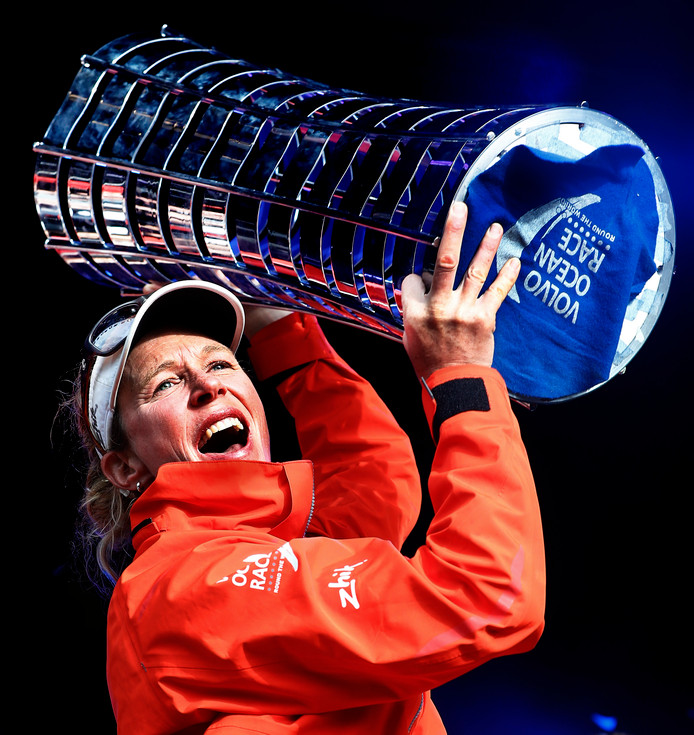
20 Aug Women in the Volvo Ocean Race
For women in the Volvo Ocean Race – and women’s sailing in general – the 2017-2018 version of the race was a seminal event. For the first time in the storied history of the Volvo, every team in the race had women sailors on their crew. And women sailors stood on the podium with the winning team – the first women to win a Volvo Ocean Race since it’s inception in 1973. Way to go Carolijn Brouwer and Marie Riou!
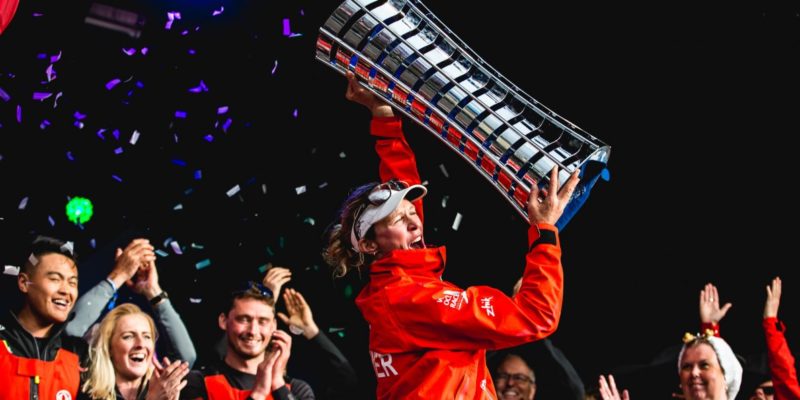
Carolijn Brouwer hoists the Volvo Ocean Race trophy after Dongfeng Racing secures their victory in Gothenburg. Photo: Pedro Martinez/Volvo Ocean Race
This radical change was a long time coming. Previous editions of the grueling round-the-world race had a fixed number of crew per boat. Given that the boats were very physical, most teams chose male sailors they perceived would have a strength advantage when stacking sails or grinding winches. In addition, most experienced offshore sailors were men. Teams looking for experience favored male sailors with offshore pedigrees.
The result was that there were very few women in the Volvo Ocean Race. And when they did participate, they were segregated onto all-female crews that sometimes struggled to compete against more experienced teams. The whole thing became a vicious cycle. Women couldn’t get on crews because they didn’t have enough experience, but they couldn’t get onboard to get the experience they needed.
Fits and starts
Women made inroads into the race in fits and starts over the years. Thanks to trailblazers like Claire Francis, Christine Guillou, Tracy Edwards, Lisa McDonald and Dawn Riley, women sailors proved more than up to the mental and physical demands of the race. But the change to one-design boats in the mid 2000’s dramatically affected women’s participation, as teams placed an even greater premium on physical strength when choosing crew.
Prior to 2018, only 122 women in total had competed in the Volvo, compared to over 2,000 men. The 2008-2009 and 2011-2012 races didn’t have a single female sailor participating. The path for women in the Volvo Ocean Race, or any crewed offshore sailing competition, remained incredibly and frustratingly narrow.
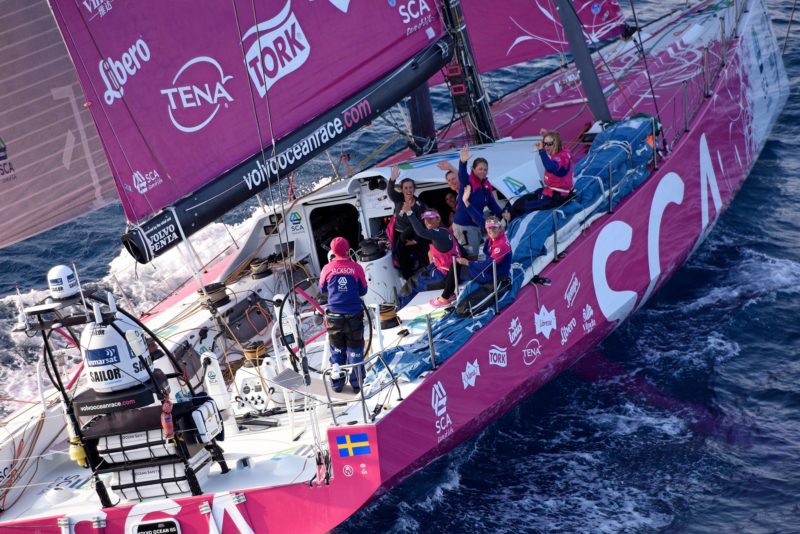
In the 2014-2015 race, Sam Davies & her all-female crew on Team SCA broke the 12 year run of no women sailing in the Volvo.
Sea change
Then in the most recent edition of the Volvo Ocean Race, the organizers made a bold – and initially controversial – rules change.
Under the new rules for team composition, teams had the option to have more crew by adding female crew members. This gave mixed-gender teams a significant numerical advantage over men-only teams. Men-only teams were limited to 7 crew. Teams with females could carry up to 10 crew. In an 8 month, 45,000 nautical mile race around 6 continents and across 4 oceans, a larger crew can make a huge difference in team performance. This threw open the doors for more women in the Volvo Ocean Race.
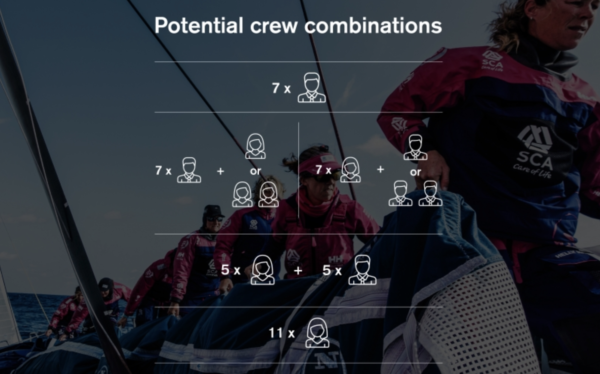
After initial reluctance from some of skippers (ahem, we’re looking at you Bouwe Bekking and David Witt), in the end all teams ended up sailing with at least 2 women on board. Offshore veteran Dee Caffari (the only female skipper in the race) and her team Turn the Tide on Plastic committed to 50% female and under-30 sailors. In doing so, she expressly gave promising but less experienced sailors a chance to compete at a world-class level. And purposely sent a strong message about inclusivity of age and gender in high-level sailing.
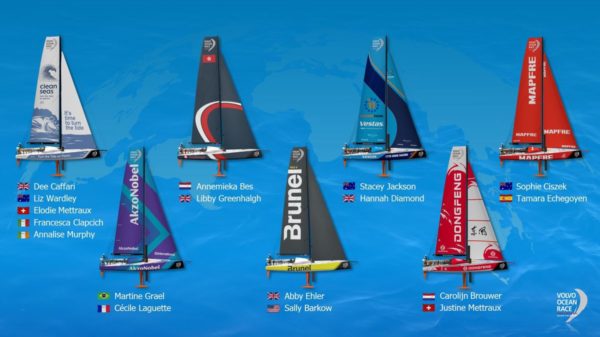
Leg 4 of the 2017-2018 Volvo Ocean Race set a record with 17 women sailors across 7 teams.
Obviously, this was a huge step forward for women in the Volvo Ocean Race and competitive sailing. Many of the women who joined this race came from Olympic dinghy backgrounds and were new to offshore racing. Having the new crew rules in place essentially helped birth a whole new class of female offshore racers. And the Volvo Ocean Race smartly sought to leverage this angle to connect with a broader audience. Witness this approach in the video, “Meet the badass women of the Volvo Ocean Race.”
No one can argue that the rule change wasn’t good for women sailors – and Volvo should be commended for forcing the issue. However, it should by no means be considered a fix for all that ails diversity in sailing. While putting on a good face for the cameras, behind the scenes women on some Volvo teams quietly expressed concerns about their limited onboard roles.
Dee Caffari, one of the most accomplished offshore sailors in the world, couldn’t even get a tryout for any of the teams in the last Volvo. To compete, she had to put together her own team. This is a woman who has sailed solo, non-stop around the world multiple times, and set speed records in the process. And yet none of the teams were willing to give her an opportunity.
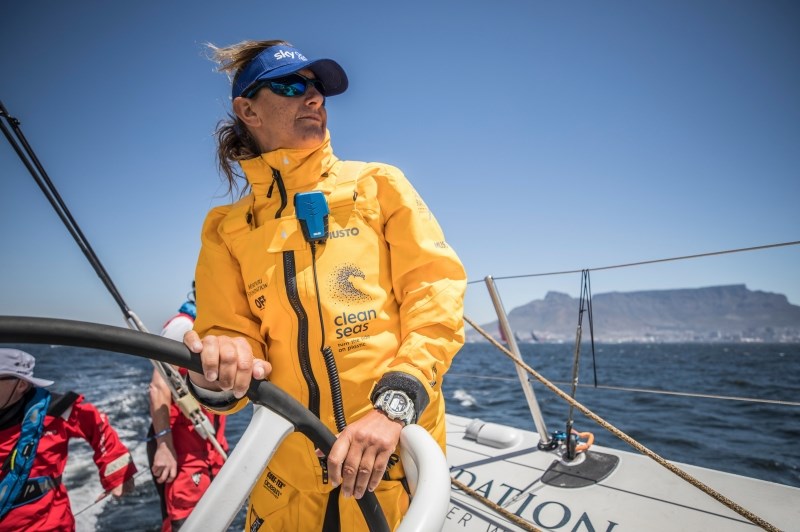
Dee Caffari at the helm of Turn the Tide on Plastic during an in-port race. Photo: PressMare.it
Caffari told the New York Times: “I think this edition of the race has been a major breakthrough, and the fact that every boat is now mixed speaks volumes, and we would never have got that without the rule change. But for me the genuine test of whether this has worked is if in the next edition there are girls actually on crews and if girls are naturally selected, and I am skeptical that would happen if we don’t still have a rule.”
Navigating forward
In other areas of professional sailing, there are still significant uphill challenges. The Americas’s Cup is still an old boy’s club. The last few Cup challenges have had no female sailors, and a scant few females even on the support teams. No women competed in the last Vendee Globe, although several are aiming to be on the line in the 2020 edition. Finding sponsorships for sailing campaigns is difficult, but twice as hard for women. Organizations like The Magenta Project are trying to help, but resources are scarce.
In fact, challenges exist even with the Volvo, which has recently changed ownership and will include both VO 65s and Imoca 60s in the next edition. Imocas typically require a smaller crew than the VO 65, and some are concerned this change could mean fewer opportunities for women in future races. Crew composition rules for the 2021-2022 race have yet to be announced.
This video produced by Volvo sponsor Argo Group tells a bit about the experience of the women on Vestas 11th Hour Racing. Maybe this is a good way to reflect on the success achieved by Volvo’s bold move – as long as we don’t lose sight of the challenges that still lie ahead for women sailors to continue to be included at the top level of the sport.
We’ve come a long way, but more needs to be done. If we want to have more women in the Volvo Ocean Race – as well as the Olympics, America’s Cup, Vendee Globe, and every other competitive sailing event – organizers will need to be thoughtful about the rules. Women have already proven they can sail just as fast as men – they just need the chance to do it. After all, as Martine Grael says: “When you’re on the water, the only thing that matters is how fast you’re going.”
Want to be inspired by some amazing women sailors? Check out our post from International Women’s Day about some of our sailing heroes: Women Sailors Rock!
